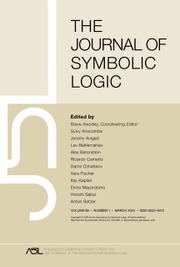Article contents
Singular σ-dense trees
Published online by Cambridge University Press: 12 March 2014
Extract
Let  be the least cardinal θ such that MAθ fails,
be the least cardinal θ such that MAθ fails,  (i.e. MA) implies that
(i.e. MA) implies that  is regular. Models for
is regular. Models for  regular with
regular with  are easy to get (see [Ku1]). Fremlin and Miller proved that cof(
are easy to get (see [Ku1]). Fremlin and Miller proved that cof( ) > ω [Fr, 41C(d)]. The question of whether it is consistent that
) > ω [Fr, 41C(d)]. The question of whether it is consistent that  be singular was solved, in the affirmative, by Kunen [Ku1]. Kunen used a (θ, θ) strong gap in
be singular was solved, in the affirmative, by Kunen [Ku1]. Kunen used a (θ, θ) strong gap in  (ω)/Fin, whose splitting partial order is c.c.c. He showed that if cof(θ) = ω1, and P is a c.c.c. partial order of cardinality < θ that may destroy the strong gap, then there exists another c.c.c. partial order Q, which does not destroy the strong gap, and such that ⊩Q “P is not c.c.c”. One then gets Kunen's model by iterating c.c.c. partial orders of cardinality < θ, without destroying the strong (θ, θ) gap. It is unknown whether it is consistent to have ω1 < cof(
(ω)/Fin, whose splitting partial order is c.c.c. He showed that if cof(θ) = ω1, and P is a c.c.c. partial order of cardinality < θ that may destroy the strong gap, then there exists another c.c.c. partial order Q, which does not destroy the strong gap, and such that ⊩Q “P is not c.c.c”. One then gets Kunen's model by iterating c.c.c. partial orders of cardinality < θ, without destroying the strong (θ, θ) gap. It is unknown whether it is consistent to have ω1 < cof( ) <
) <  .
.
Clearly, there exists a c.c.c. partial order Q with ∣Q∣ =  , such that
, such that  (Q) =
(Q) =  (see (1.1)). A partial order P is σ-centered iff P is the union of countably many centered subsets, where a subset A ⊆ P is centered iff
(see (1.1)). A partial order P is σ-centered iff P is the union of countably many centered subsets, where a subset A ⊆ P is centered iff  p ≤ q. Clearly, a σ-centered partial order is c.c.c. Bell and Szymański proved that
p ≤ q. Clearly, a σ-centered partial order is c.c.c. Bell and Szymański proved that  (σ-centered) is regular (see [Be] or [Fr, 14C], and [Fr, 21K] or [vD, 3.1(e)]). This implies that if P is a σ-centered partial order, and
(σ-centered) is regular (see [Be] or [Fr, 14C], and [Fr, 21K] or [vD, 3.1(e)]). This implies that if P is a σ-centered partial order, and  is singular, then
is singular, then  (P) >
(P) >  . In particular, if
. In particular, if  is singular, then Q is not σ-centered and all c.c.c. partial orders of cardinality <
is singular, then Q is not σ-centered and all c.c.c. partial orders of cardinality < have a Baire number (1.1) strictly greater than
have a Baire number (1.1) strictly greater than  . It was suggested in [Ku1] to try and use Q(T) (1.2), where T is a tree with no ω1-branches, to get models with singular
. It was suggested in [Ku1] to try and use Q(T) (1.2), where T is a tree with no ω1-branches, to get models with singular  . It is well known that when T is such a tree, the forcing Q(T) is c.c.c. [BMR], ∣Q(T)∣ = ∣T∣, and if T is not special, then n(Q(T)) ≤ ∣T∣.
. It is well known that when T is such a tree, the forcing Q(T) is c.c.c. [BMR], ∣Q(T)∣ = ∣T∣, and if T is not special, then n(Q(T)) ≤ ∣T∣.
Information
- Type
- Research Article
- Information
- Copyright
- Copyright © Association for Symbolic Logic 1992
References
REFERENCES
- 1
- Cited by

